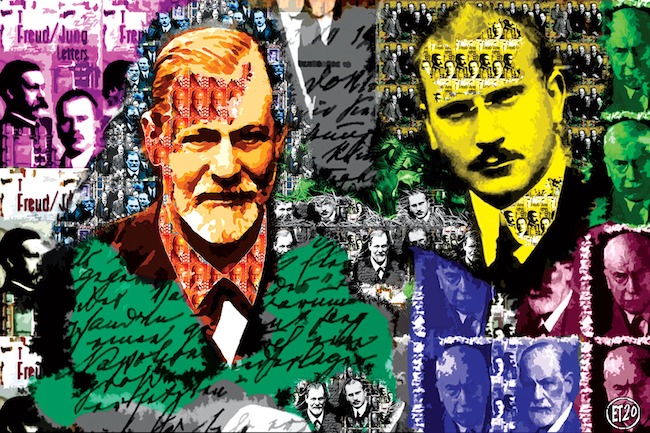La capacità di andare a cogliere i dettagli dei frammenti di esistenza delle persone che in qualche modo incrociano, intersecano, il proprio cammino con quello dell’altro, è fortemente legata alla sensibilità attraverso la quale l’artista si lascia conquistare in virtù della sua capacità empatica, quel saper riconoscere i frangenti importanti e sostanziali che restano indelebili nella memoria emotiva. Il protagonista di oggi ha dato vita a uno stile originale e personale che gli consente di cogliere quegli attimi salienti e di restituirli al fruitore attraverso opere che dalla loro totalità richiamano immediatamente l’attenzione sui piccoli dettagli che la costituiscono.
Il mosaico affonda le sue radici in un passato molto lontano eppure non ha mai smesso di costituire un affascinante modo di raffigurare la realtà e di costituire una preziosa forma di espressione artistica che le classi più abbienti non potevano far mancare per adornare le proprie case; il concetto della composizione del mosaico era di formare un’immagine completa attraverso l’unione di tessere, ciascuna con una piccola parte della realtà che doveva rappresentare e che solo accostandosi alla conseguente e contigua altra tessera poteva raggiungere un senso compiuto una volta terminata l’opera. Il medesimo tema della frammentazione della rappresentazione di ciò che l’occhio osservava, o forse sarebbe meglio dire la sua ricomposizione, per dar vita a un insieme figurativo fu ripreso nell’Impressionismo, in cui il risultato finale veniva raggiunto attraverso brevi e rapide pennellate che solo da lontano e dopo aver terminato l’opera, potevano rimandare ciò che lo sguardo dell’artista aveva davanti allo sguardo nel momento in cui cominciava a dipingere. Poco dopo questa suddivisione fu ripresa ed enfatizzata dai Divisionisti per i quali solo attraverso brevi linee di colore sarebbe stato possibile catturare la luce e le molteplici sfaccettature dei paesaggi e panorami descritti; il concetto si è poi ampliato nel Futurismo, in cui la suddivisione divenne più grande e parti di realtà venivano ripetuti e riproiettati su se stessi per infondere nell’osservatore l’idea del movimento e della velocità che erano le linee guida del movimento, e nel Cubismo per cui era fondamentale osservare oggetti e personaggi da differenti punti di vista nel medesimo istante rendendo perciò la frammentazione funzionale a una visione contemporanea di tutte le angolazioni escludendo la presenza della terza dimensione. Anche la Pop Art, anni dopo queste prime correnti del Novecento, ripropose, variandola notevolmente, la suddivisione in tessere che però non erano più funzionali a comporre un risultato finale, laddove ciascuna parte era imprescindibile dalla precedente e dalla successiva per costruire l’immagine, bensì erano una reiterazione, una ripetizione quasi ossessiva del medesimo fotogramma raccontato però attraverso gamme cromatiche differenti, per sottolineare quanto le icone dell’epoca fossero presenti e invasive nella vita quotidiana. Enrico Tubertini, artista bolognese con un passato da regista televisivo e cinematografico, fa sua l’arte del mosaico partendo però dal concetto opposto a quello abituale, perché nelle sue opere personografiche le tessere, fotografiche nel suo caso, compongono sì un’immagine finale ma hanno il loro senso solo se si osservano con attenzione, se ci si avvicina e si ascolta la storia che ciascun tassello racconta. Il suo stile Pop Digital è innovativo e particolare perché all’interno nasconde non solo i dettagli della vita dei protagonisti delle sue opere, che possono essere persone comuni o personaggi famosi che lo ispirano per la traccia che hanno lasciato con il loro cammino, le loro ricerche o il loro talento, bensì anche l’intera storia di una vita oppure solo di una parte di essa che rappresenta in pieno l’essenza e la sostanza di chi ne è stato protagonista. Ama i colori Enrico Tubertini, dunque non può fare a meno di scegliere quell’approccio Pop che gli consente di trasformare le immagini selezionate in mondi variopinti che a volte esaltano, altre stemperano la solennità di alcuni frangenti proposti nelle sue personografie, e anche di convertire alcuni di quei frammenti compositivi in altre opere singole che assumono un fascino assolutamente particolare.
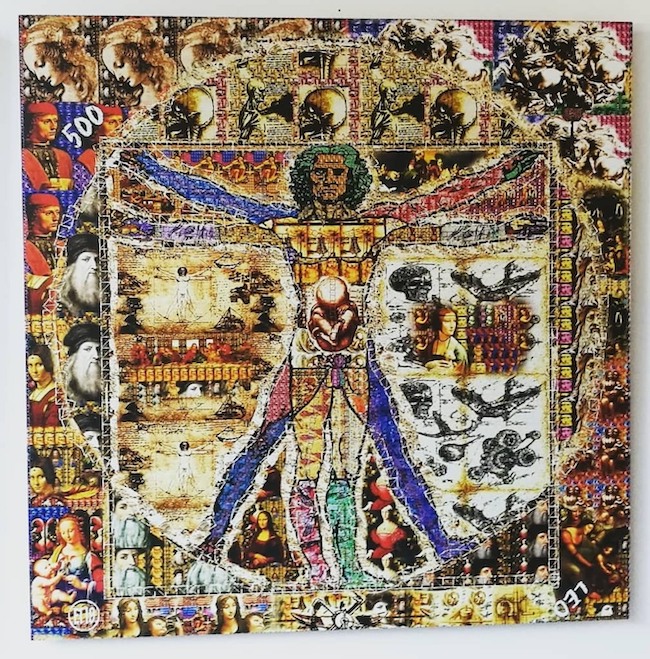
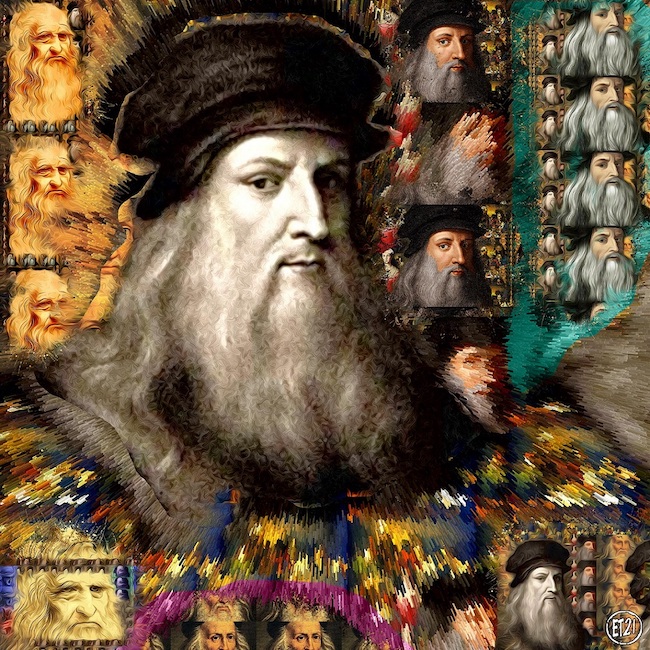
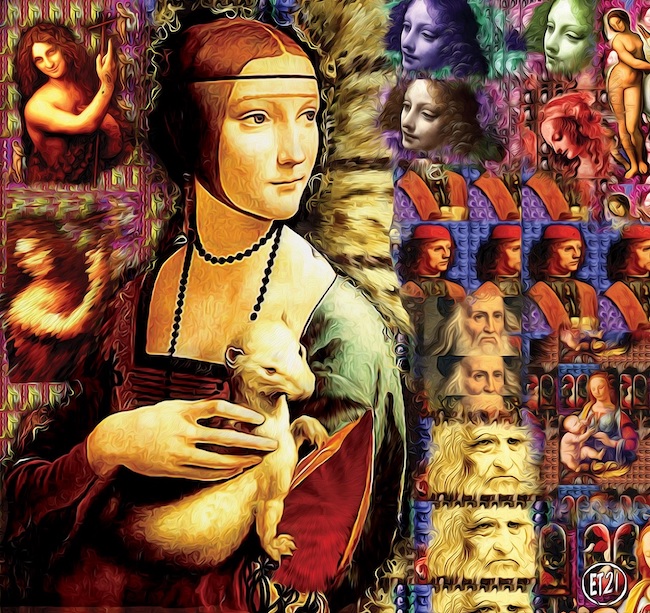
Nell’opera Leo500, creata in occasione dei cinquecento anni dalla morte del grande maestro Leonardo da Vinci, Tubertini prende come contenitore di emozioni l’Uomo Vitruviano, che diviene così non solo protagonista bensì anche modello ispiratore per approfondire i momenti salienti della storia del genio del Rinascimento, come artista ma anche come scienziato e inventore; all’interno della personografia sono presenti immagini dei dipinti più celebri, dei suoi studi sul volo, alcune curiosità poco conosciute, come la passione di Leonardo per il vino rosso che viene simboleggiata dall’artista con un calice molto vicino all’immaginario comune del Graal, e la sintesi compiuta sul senso dell’uomo che in fondo rappresenta l’umanità intera e di cui il neonato posto al centro del suo addome rappresenta secondo Tubertini la capacità di generare e proseguire il percorso evolutivo e conoscitivo dell’esistenza. Attualmente questa personografia è esposta al Museo delle Macchine di Leonardo a Venezia.

In Freud l’artista compie un percorso nella storia dello psicanalista austriaco, nei suoi studi, nelle sue ricerche ma anche all’interno dei suoi legami familiari, dei momenti salienti della sua carriera, dei suoi scritti e del suo antagonismo con l’ex allievo Carl Gustav Jung; sono delle vere e proprie ricerche quelle che compie Enrico Tubertini ogni qualvolta decide di produrre una nuova opera, si insinua nella storia, nei percorsi e nelle curiosità che avvolgono le esistenze di grandi personaggi come delle persone comuni che gli commissionano la realizzazione di un lavoro che parli di loro.
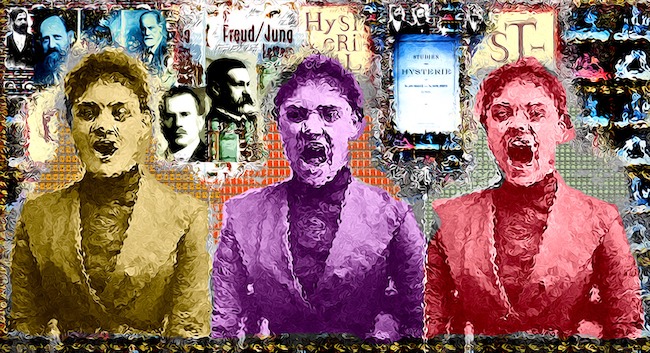
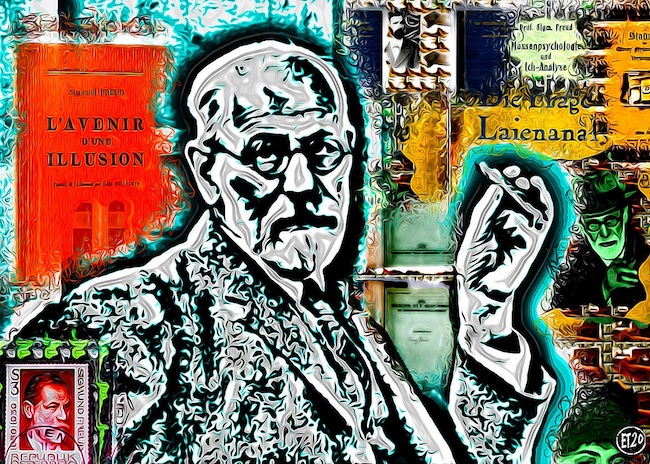
Nel caso di Freud particolarmente affascinanti sono anche le opere estrapolate dalla personografia principale, quelle che l’artista definisce trasmutografie e che sono di fatto le tessere, i piccoli fotogrammi visibili all’interno dell’immagine principale; Hysterya, Psyco (l’opera in copertina articolo), Tra le righe sono simboli del percorso dello psicanalista austriaco ma anche testimonianze di quanto lo stile di Tubertini sia indissolubilmente legato all’approccio Pop pur applicandolo a materie più intellettuali rispetto a quelle popolari e di uso comune che contraddistinguevano il movimento fondato da Andy Warhol. È proprio questo il fascino della creatività dell’artista, quel riuscire a mescolare storia e leggerezza compositiva, restituendo all’osservatore memorie del passato, degli insegnamenti ricevuti a scuola, con una nuova veste che li rende attuali e fruibili, oltre a essere dimostrazione che a volte anche ciò che sembrerebbe noioso può invece diventare divertente e stimolante.
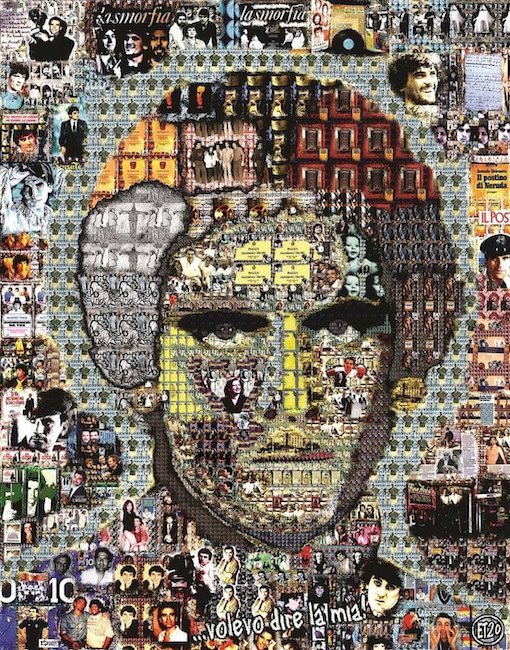
In Zio Massimo, personografia dedicata a Massimo Troisi ed esposta a Castel dell’Ovo, Napoli, in una mostra dedicata all’attore prematuramente scomparso, Tubertini racconta i momenti salienti della carriera cinematografica e umana dell’uomo, prima che dell’artista, quel suo essere semplice e spontaneo, la sua generosità e la capacità di raccontare le debolezze umane, le fragilità ma anche la tendenza a sdrammatizzare che contraddistingue il popolo partenopeo; l’opera è piena di tutti i personaggi che hanno interagito e lavorato con Massimo Troisi, delle soddisfazioni e i premi ricevuti, e soprattutto della sua capacità di sorridere, sempre e comunque. Enrico Tubertini ha all’attivo molte mostre collettive in Italia – Roma, Venezia, Bologna, Milano, Teramo – e all’estero – Zurigo, Copenhagen e nei prossimi mesi esporrà a Vienna e Lisbona -, una mostra personale, Ritratti Ri-trattati, presso la Galleria d’Arte Contemporanea di Faenza, ha ricevuto diversi riconoscimenti e un terzo premio per l’opera Fake or News?; attualmente Leo 500 è stata selezionata per concorrere al Premio Cairo 2021.
ENRICO TUBERTINI-CONTATTI
Email: pittoet@gmail.com
Sito web: www.enricotubertini.wixsite.com/pittografia
Facebook: https://www.facebook.com/cambiaresipuo69
Instagram: https://www.instagram.com/enricotuber/
Emotions and narration in Enrico Tubertini’s personalised artworks, between Pop Digital and mosaics enclosing stories
The ability to capture the details of the fragments of people’s existence who somehow cross, intersect, their own path with that of others, is strongly linked to the sensitivity through which the artist allows himself to be conquered by virtue of his empathic ability, that being able to recognise the important and substantial junctures that remain indelible in the emotional memory. Today’s protagonist has created an original and personal style that allows him to capture those salient moments and return them to the viewer through artworks that from their totality immediately draw attention to the small details that constitute it.
Mosaics have their roots in a very distant past, yet they have never ceased to be a fascinating way of depicting reality and a precious form of artistic expression that the wealthier classes could not fail to use to adorn their homes. The concept of mosaic composition was to form a complete image through the union of tesserae, each with a small part of the reality it was meant to represent, and which only by being brought together with the consequent and contiguous other tessera could reach a complete meaning once the work was finished. The same theme of fragmentation of the representation of what the eye observed, or perhaps it would be better to say its recomposition, in order to give life to a figurative whole, was taken up again in Impressionism, in which the final result was achieved through short, rapid brushstrokes that only from a distance and after the painting had been completed could convey what the artist’s gaze had in front of him at the moment he started to paint. Shortly afterwards, this subdivision was taken up and emphasised by the Divisionists for whom only through short lines of colour would it be possible to capture the light and the many facets of the landscapes and panoramas described; the concept was then expanded in Futurism, in which the subdivision became larger and parts of reality were repeated and reprojected on themselves to instil in the observer the idea of movement and speed that were the guidelines of the movement, and in Cubism for which it was essential to observe objects and characters from different points of view at the same time, thus making the fragmentation functional to a contemporary vision of all angles excluding the presence of the third dimension.
Even Pop Art, years after these early twentieth-century currents, re-proposed the subdivision into tesserae, varying it considerably, but these were no longer functional to compose a final result, where each part was inseparable from the previous and the next to construct the image, but were a reiteration, an almost obsessive repetition of the same frame told through different colour ranges, to underline how present and invasive the icons of the time were in everyday life. Enrico Tubertini, an artist from Bologna with a past as a television and film director, makes the art of the mosaic his own, but starting from the opposite concept to the usual one, because in his personographied artworks the tesserae, photographic in his case, do indeed make up a final image, but they only make sense if you look at them carefully, if you approach them and listen to the story that each piece tells. His Pop Digital style is innovative and particular because inside it hides not only the details of the lives of the protagonists of his works, who may be ordinary people or famous people who inspire him for the trace they have left with their path, their research or their talent, but also the whole story of a life or just a part of it that fully represents the essence and substance of the person who has been protagonist. Enrico Tubertini loves colours, so he can’t help but choose that Pop approach that allows him to transform the selected images into multicoloured worlds that at times enhance, at others dilute the solemnity of some of the moments proposed in his portraits, and also to convert some of those compositional fragments into other individual artworks that take on a very special charm.
In the work Leo500, created on the occasion of the 500th anniversary of the death of the great master Leonardo da Vinci, Tubertini takes the Vitruvian Man as a container of emotions, making him not only the protagonist but also an inspiring model for exploring the salient moments in the history of the Renaissance genius, as an artist but also as a scientist and inventor. The personography includes images of his most famous paintings, his studies on flight, some little-known curiosities, such as Leonardo’s passion for red wine, symbolised by the artist with a chalice very close to the common image of the Grail, and the synthesis on the meaning of man, which basically represents the whole of humanity and of which the newborn child placed in the centre of his abdomen represents, according to Tubertini, the capacity to generate and continue the evolutionary and cognitive path of existence. This personography is currently on display at the Museo delle Macchine di Leonardo in Venice. In Freud the artist follows the history of the Austrian psychoanalyst, his studies, his research, but also his family ties, the salient moments of his career, his writings and his antagonism with his former pupil Carl Gustav Jung. Enrico Tubertini carries out real research every time he decides to produce a new artwork, he insinuates himself into the history, the paths and the curiosities that surround the lives of great personalities as well as ordinary people who commission him to create a work that speaks about them. In the case of Freud, particularly fascinating are also the artworks extrapolated from the main character, what the artist defines as transmutographies and that are in fact the tesserae, the small frames visible inside the main image; Hysterya, Psyco, Tra le righe are symbols of the Austrian psychoanalyst’s path but also testimonies of how Tubertini’s style is indissolubly linked to the Pop approach even though applying it to more intellectual subjects compared to the popular and commonly used ones that distinguished the movement founded by Andy Warhol.
This is the fascination of the artist’s creativity, his ability to mix history and lightness of composition, giving the observer memories of the past, of the teachings he received at school, in a new guise that makes them current and usable, as well as demonstrating that sometimes even what seems boring can become fun and stimulating. In Zio Massimo, a personography dedicated to Massimo Troisi and exhibited at Castel dell’Ovo, Naples, in an exhibition dedicated to the prematurely deceased actor, Tubertini recounts the salient moments of the cinematographic and human career of the man, before that of the artist, his being simple and spontaneous, his generosity and ability to recount human weaknesses, fragilities but also the tendency to play down that distinguishes the Neapolitan people; the artwork is full of all the characters who interacted and worked with Massimo Troisi, of the satisfactions and awards he received, and above all of his ability to smile, always and in any case. Enrico Tubertini has had many group exhibitions in Italy – Rome, Venice, Bologna, Milan, Teramo – and abroad – Zurich, Copenhagen and in the next few months he will be exhibiting in Vienna and Lisbon -, a personal exhibition, Ritratti Ri-trattati, at the Galleria d’Arte Contemporanea in Faenza, has received several awards and a third prize for the work Fake or News?; Leo 500 has currently been selected to compete for the Cairo 2021 Prize.


